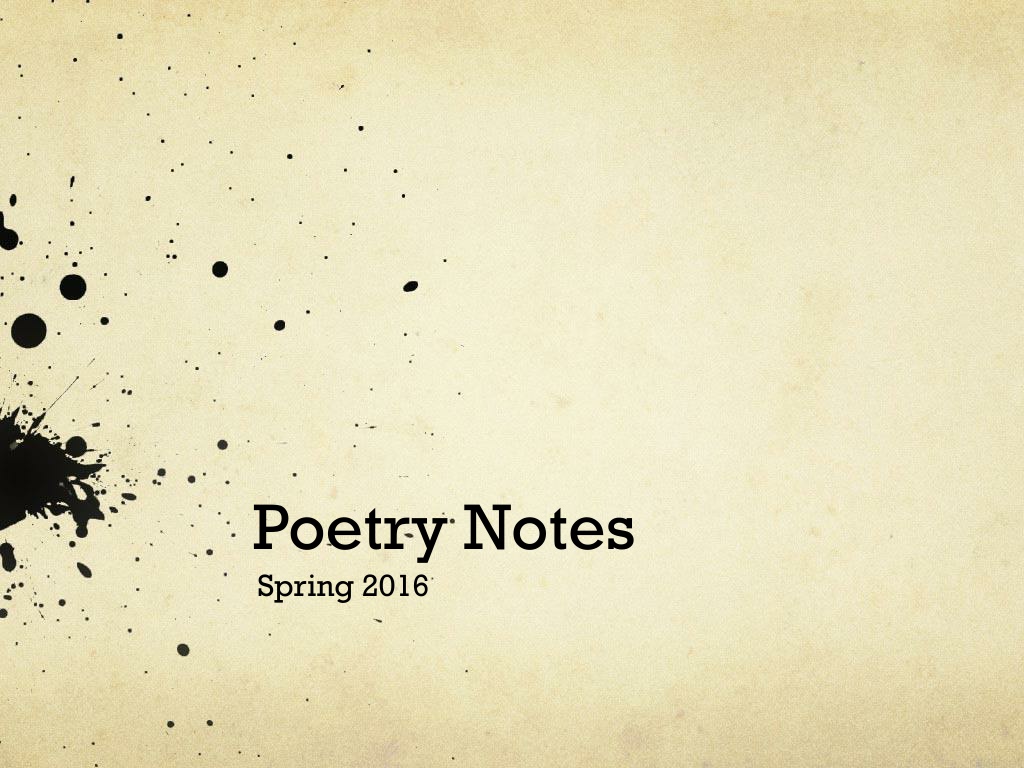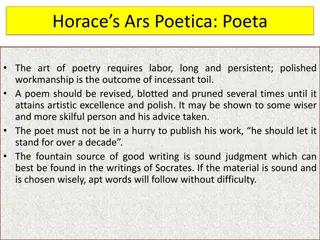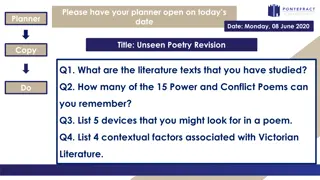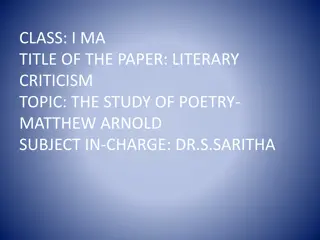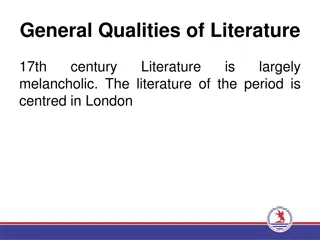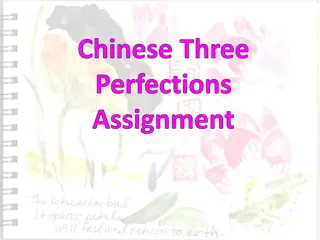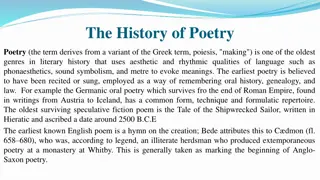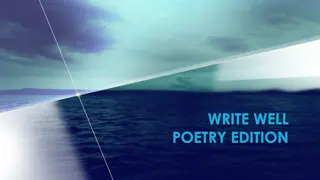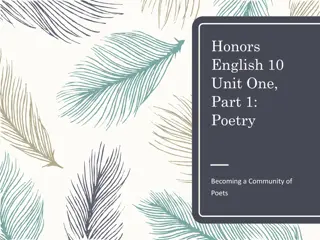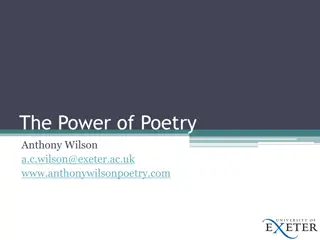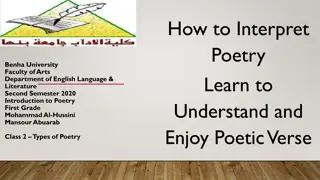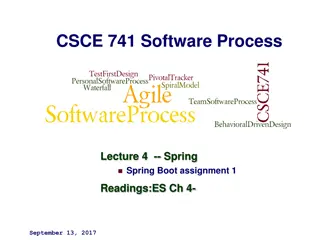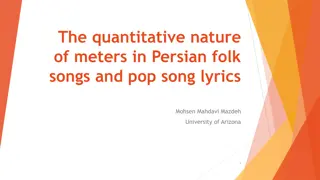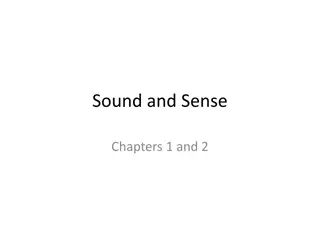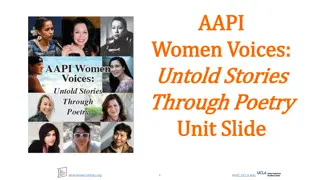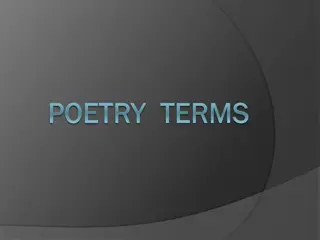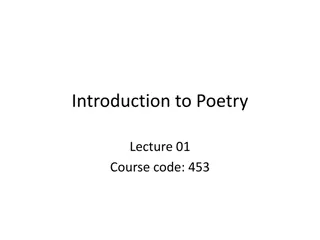Exploring Poetry Elements in Spring 2016 Notes
Poetry, a blend of literary and musical features, encompasses metaphors, similes, imagery, rhyme, meter, and more. This form of art can evoke various emotions and themes through techniques like personification, imagery, alliteration, end rhyme, and internal rhyme. Dive into the beauty of language and sound in poetry.
Download Presentation

Please find below an Image/Link to download the presentation.
The content on the website is provided AS IS for your information and personal use only. It may not be sold, licensed, or shared on other websites without obtaining consent from the author. Download presentation by click this link. If you encounter any issues during the download, it is possible that the publisher has removed the file from their server.
E N D
Presentation Transcript
Poetry Notes Spring 2016
What is poetry? Poetry contains both literary and musical features (meaning of the words combined with how they sound when linked together). On the literary side, poetry can use any combination of metaphor, simile, imagery, symbolism, allegory, even narrative or storyline. On the musical side, poetry uses rhyme, meter, assonance (similar vowels) and alliteration (similar consonants) to strike an acoustic mood or tone. Poetry can be ironic or humorous, attractive or ugly, mystical or mundane. Denotation (direct meaning) and connotation (indirect meaning) help to further sculpt the literary meaning or sense of a poem.
Alliteration The repetition of consonant sounds, especially at the beginning of words. Example: Hopkins, "In the Valley of the Elwy." "F Fetched f fresh, as I suppose, off s some s sweet wood.
End Rhyme When a poem has lines ending with words that sound the same. (noun). An example of end rhyme is the poem, Star Light, Star Bright. Star light, star bright. First start I see tonight. I wish I may, I wish I might, I have the wish I wish tonight.
Internal Rhyme Rhyme in the same line comes when the words rhyme in a single line. For example, Once upon a midnight dreary, while I pondered, weak and weary, While I nodded, nearly napping, suddenly there came a tapping, As of someone gently rapping, rapping at my chamber door.
Personification The endowment of inanimate objects or abstract concepts with animate or living qualities. Verb = action that is not usually associated with leaves. Leaves = non-living object An example: "The yellow leaves flaunted their color gaily in the breeze." Wordsworth's "I wandered lonely as a cloud" includes personification.
Imagery The pattern of related comparative aspects of language, particularly of images, in a literary work. Visualize Examples: He could never escape from the iron grip of desire. The pot was a red as a tongue after eating a cherry flavored ring pop. Imagery of light and darkness pervade James Joyce's stories "Araby," "The Boarding House," and "The Dead." So, too, does religious imagery.
Metaphor A comparison between essentially unlike things without an explicitly comparative word such as like or as. An example is "My love is a red, red rose," From Burns's "A Red, Red Rose." Langston Hughes's "Dream Deferred" is built entirely of metaphors. Metaphor is one of the most important of literary uses of language. Shakespeare employs a wide range of metaphor in his sonnets and his plays, often in such density and profusion that readers are kept busy analyzing and interpreting and unraveling them.
Simile A figure of speech involving a comparison between unlike things using like, as, or as though. An example: "My love is like a red, red rose."
Synecdoche [si-nek-duh-kee] A figure of speech in which a part is substituted for the whole. An example: "Lend me a hand. Another example: The word "wheels" refers to a vehicle.
Hyperbole A figure of speech involving exaggeration. An example from Homer s The Odyssey include the lines suggesting that the god Ares cried out "as loudly as nine or ten thousand men" John Donne uses hyperbole in his poem: "Song: Go and Catch a Falling Star."
Symbolism The practice of representing things by symbols, or of investing things with a symbolic meaning or character. A symbol is an object, action, or idea that represents something other than itself, often of a more abstract nature. Symbolism creates quality aspects that make literature like poetry and novels more meaningful. Examples: Roses stand for romance. Striking out of the game represent defeat or rejection. Archetypes are the popular reoccurring symbols.
Lyric A type of poem characterized by brevity, compression, and the expression of feeling. The Emily Dickinson s I Felt a Funeral In My Brain" epitomizes the genre: I felt a Funeral, in my Brain, And Mourners to and fro Kept treading - treading - till it seemed That Sense was breaking through - And when they all were seated, A Service, like a Drum -Kept beating - beating - till I thought My Mind was going numb -
Narrative A poem that tells a story. Ballad- A narrative poem written in four-line stanzas, characterized by swift action and narrated in a direct style. The Anonymous medieval ballad, "Barbara Allan," exemplifies the genre.
Generally, a form of poetry that has a name; specifically, any of the standard, highly- structured arrangements of meter, rhyme patterns, and/or topics that define a poem. Rules Use figurative language Connect with other poets Pay attention to form Bare yourself Examples: ballad, didactic, haiku, epic poem, limerick, ode, cinquain, shaped verse, sonnet, sestina, etc Learn the rules and brake them 1.
Sonnet A fourteen-line poem in iambic pentameter. The Shakespearean or English sonnet is arranged as three quatrains and a final couplet, rhyming abab cdcd efef gg. The Petrarchan or Italian sonnet divides into two parts: an eight-line octave and a six-line sestet, rhyming abba abba cde cde or abba abba cd cd cd.
Couplet A pair of rhymed lines that may or may not constitute a separate stanza in a poem. Shakespeare's sonnets end in rhymed couplets, "For thy sweet love remembered such wealth brings / That then I scorn to change my state with kings."
